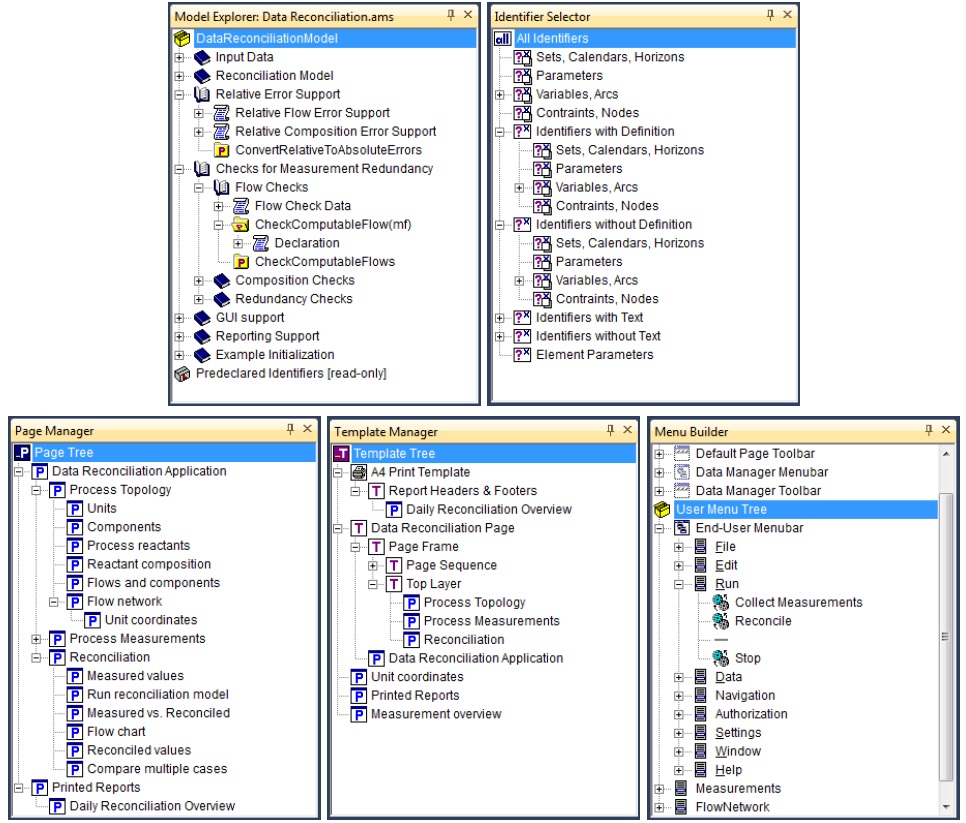Modeling tools
Modeling tools
Once you have created a new project and associated a model file with it, AIMMS offers a number of graphical tree-based tools to help you further develop the model and its associated end-user interface. The available tools are:
the Model Explorer,
the Identifier Selector,
the Page Manager,
the Template Manager, and
the Menu Builder tool.
These tools can be accessed either through the Tools menu or via the project toolbar. They are all aimed at reducing the amount of work involved in developing, modifying and maintaining particular aspects of your model-based end-user application. Fig. 3 provides an overview of the windows associated with each of these tools.

Fig. 3 Overview of Aimms tools
The Model Explorer
The AIMMS Model Explorer provides you with a simple graphical representation of all the identifiers, procedures and functions in your model. All relevant information is stored in the form of a tree, which can be subdivided into named sections to store pieces of similar information in a directory-like structure. The leaf nodes of the tree contain the actual declarations and the procedure and function bodies that make up the core of your modeling application. The Model Explorer is discussed in full detail in The Model Explorer.
The Identifier Selector
While the Model Explorer is a very convenient tool to organize all the information in your model, the Identifier Selector allows you to select and simultaneously view the attributes of groups of identifiers that share certain functional aspects in your model. By mutual comparison of the important attributes, such overviews may help you to further structure and edit the contents of your model, or to discover oversights in a formulation. The Identifier Selector is discussed in full detail in Viewing Identifier Selections
The Page Manager
Warning
The AIMMS WinUI and the page manager are deprecated, please refer to AIMMS Product Lifecycle. You may use the WebUI instead, and WebUI Page Manager
The Page Manager allows you to organize all end-user windows associated with an AIMMS application (also referred to as end-user pages) in a tree-like fashion. The organization of pages in the page tree directly defines the navigational structure of the end-user interface. Relative to a particular page in the page tree, the positions of the other pages define common relationships such as parent page, child page, next page or previous page, which can used in navigational controls such as buttons and menus.
The Template Manager
Warning
The AIMMS WinUI and the page manager are deprecated, please refer to AIMMS Product Lifecycle. You may use the WebUI instead.
Within the Template Manager, you can make sure that all end-user pages have the same size and possess the same look and feel. You can accomplish this by creating page templates which define the page properties and objects common to a group of end-user pages, and by subsequently placing all end-user pages into the tree of page templates.
The Menu Builder
Warning
The AIMMS WinUI and the page manager are deprecated, please refer to AIMMS Product Lifecycle. You may use the WebUI instead, and the WebUI Page Menu
With the Menu Builder you can create customized menu bars, pop-up menus and toolbars that can be linked to either template pages or end-user pages in your application. In the menu builder window you can define menus and toolbars in a tree-like structure similar to the other page-related tools, to indicate the hierarchical ordering of menus, submenus and menu items.